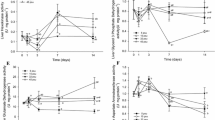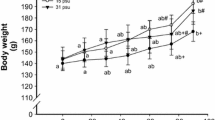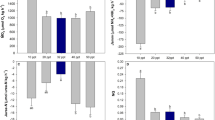Abstract
The penaeid prawn, Litopenaeus vannamei, was employed to investigate intracellular isosmotic regulation in situations where invertebrates encounter hyposmosis. Hemolymph osmolality was first analyzed to confirm osmoregulatory conditions in the experimental animals, followed by analysis of amino acids in muscle and hemolymph using high-performance liquid chromatography. Total muscle amino acid levels decreased when hemolymph osmolality was extremely low, whereas glycine and l-serine levels increased in the hemolymph. These results suggest that tissue amino acids were released into the hemolymph to lower the osmolality of the tissues for purposes of low-salinity adaptation. Next, oxygen consumption and ammonia excretion rates were examined, and the O/N ratio was determined. Oxygen consumption levels and ammonia excretion rates increased, and the O/N ratio decreased when the animals were exposed to low salinity. These results suggest that amino acids were abundantly consumed as an energy source when animals were exposed to low salinity. To confirm the consumption of particular amino acids, the specific activity of l-serine ammonia lyase was also examined. Specific activity was highest when l-serine levels in the hemolymph were highest. Thus, it appears that l-serine levels increased under hyposmotic conditions due to the consumption of l-serine as an energy source. It was concluded that particular amino acids as osmolytes are likely metabolized as energy sources and consumed for purposes of hyposmotic adaptation.





Similar content being viewed by others
References
Abe H, Okuma E, Amano H, Noda H, Watanabe K (1999) Effects of seawater acclimation on the levels of free d- and l-alanine and other osmolytes in the Japanese mitten crab Eriocheir japonicus. Fish Sci 65:949–954
Abe H, Yoshikawa N, Sarower MG, Okada S (2005a) Physiological function and metabolism of free d-alanine in aquatic animals. Biol Pharm Bull 28:1571–1577
Abe H, Yoshikawa N, Sarower MG, Okada S (2005b) Distribution, metabolism, and physiological functions of free d-amino acids in invertebrates. Vitam (Japan) 79:79–86
Ahearn GA, Duerr JM, Zhuang Z, Brown RJ, Aslamkhan A, Killebrew DA (1999) Ion transport processes of crustacean epithelial cells. Physiol Biochem Zool 72:1–18
Ahearn GA, Mandal PK, Mandal A (2004) Calcium regulation in crustaceans during the molt cycle: a review and update. Comp Biochem Physiol 137A:247–257
Augusto A, Greene LJ, Laure HJ, McNamara JC (2007a) Adaptive shifts in osmoregulatory strategy and the invasion of freshwater by brachyuran crabs: evidence from Dilocarcinus pagei (Trichodactylidae). J Exp Zool 307A:688–698
Augusto A, Greene LJ, Laure HJ, McNamara JC (2007b) The ontogeny of isosmotic intracellular regulation in the diadromous, freshwater palaemonid shrimps, Macrobrachium amazonicum and M. olfersi (Decapoda). J Crustacean Biol 27:626–634
Augusto A, Pinheiro AS, Greene LJ, Laure HJ, McNamara JC (2009) Evolutionary transition to freshwater by ancestral marine palaemonids: evidence from osmoregulation in a tide pool shrimp. Aquat Biol 7:113–122
Bett C, Vinatea L (2009) Combined effect of body weight, temperature and salinity on shrimp Litopenaeus vannamei oxygen consumption rate. Braz J Oceanogr 57:305–314
Boone WR, Schoffeniels E (1979) Hemocyanin synthesis during hypo-osmotic stress in the shore crab Carcinus maenas (L.). Comp Biochem Physiol 63B:207–214
Cech JJ Jr (1990) Respirometry. In: Schreck CB, Moyle PB (eds) Methods for fish biology. American Fish Society, Lane Bethesda, pp 335–361
Chan SM, Rankin SM, Keeley LL (1988) Characterization of the molt stage in Penaeus vannamei: setogenesis and hemolymph levels of total protein, ecdysteroids, and glucose. Biol Bull 175:185–192
Charmantier G, Charmantier-Daures M, Towle D (2009) Osmotic and ionic regulation in aquatic arthropods. In: Evans DH (ed) Osmotic and ionic regulation: cells and animals. CRC Press, Florida, pp 231–279
Che Mat CRB, Potts WTW (1985) Intracellular osmotic regulation in Crangon vulgaris. Comp Biochem Physiol 82A:719–724
Chen JC, Chia PG (1996) Hemolymph ammonia and urea and nitrogenous excretions of Scylla serrata at different temperature and salinity levels. Mar Ecol Prog Ser 139:119–125
Chen JC, Lai SH (1993) Effects of temperature and salinity on oxygen consumption and ammonia–N excretion of juvenile Penaeus japonicas Bate. J Exp Mar Biol Ecol 165:161–170
Chen JC, Nan FH (1993) Changes of oxygen consumption and ammonia–N excretion by Penaeus chinensis Osbeck at different temperature and salinity levels. J Crustacean Biol 13:706–712
Chen JC, Chen CT, Cheng SY (1994) Nitrogen excretion and changes of hemocyanin, protein and free amino acid levels in the hemolymph of Penaeus monodon exposed to different concentrations of ambient ammonia–N at different salinity levels. Mar Ecol Prog Ser 110:85–94
Corner EDS, Cowey CB (1968) Biochemical studies on the reproduction of marine zooplankton. Biol Rev 43:393–426
Curtis DL, McGaw IJ (2010) Respiratory and digestive responses of postprandial Dungeness crabs, Cancer magister, and blue crabs, Callinectes sapidus, during hyposaline exposure. J Comp Physiol 180B:189–198
Dalla Via GJ (1986) Salinity responses of the juvenile penaeid shrimp Penaeus japonicas II. Free amino acids. Aquaculture 55:307–316
Dooley PC, Long BM, West JM (2000) Amino acids in haemolymph, single fibres and whole muscle from the claw of freshwater crayfish acclimated to different osmotic environments. Comp Biochem Physiol 127A:155–165
Faria SCD, Augusto AS, McNamara JC (2011) Intra- and extracellular osmotic regulation in the hololimnetic Caridea and Anomura: a phylogenetic perspective on the conquest of fresh water by the decapod Crustacea. J Comp Physiol B 181:175–186
Foster C, Amado EM, Souza MM, Freire CA (2009) Do osmoregulators have lower capacity of muscle water regulation than osmoconformers? A study on decapod crustaceans. J Exp Zool 313A:80–94
Freire CA, Amado EM, Souza LR, Veiga MPT, Vitule JRS, Souza MM, Prodocimo V (2008a) Muscle water control in crustaceans and fishes as a function of habitat, osmoregulatory capacity, and degree of euryhalinity. Comp Biochem Physiol 149A:435–446
Freire CA, Onken H, McNamara JC (2008b) A structure–function analysis of ion transport in crustacean gills and excretory organs. Comp Biochem Physiol 151A:272–304
Fujimori T, Abe H (2002) Physiological roles of free d- and l-alanine in the crayfish Procambarus clarkii with special reference to osmotic and anoxic stress responses. Comp Biochem Physiol 131A:893–900
Gilles R (1977) Effects of osmotic stresses on the proteins concentration and pattern of Eriocheir sinensis blood. Comp Biochem Physiol 56A:109–114
Gilles R, Péqueux A (1981) Cell volume regulation in crustaceans: relationship between mechanisms for controlling the osmolality of extracellular and intracellular fluids. J Exp Zool 215:351–362
Greenaway P (2001) The Crustacea. In: Anderson DT (ed) Invertebrate zoology, 2nd edn. Oxford University Press, South Melbourne, pp 293–322
Haberfield EC, Waas LW, Hammen CS (1975) Early ammonia release by a polychaete Nereis virens and a crab Carcinus maenas in diluted sea water. Comp Biochem Physiol 52A:501–503
Huong DTT, Jasmani S, Jayasankar V, Wilder M (2010) Na/K-ATPase activity and osmo-ionic regulation in adult whiteleg shrimp Litopenaeus vannamei exposed to low salinities. Aquaculture 304:88–94
Lemos D, Phan VN, Alvarez G (2001) Growth, oxygen consumption, ammonia–N excretion, biochemical composition and energy content of Farfantepenaeus paulensis Pérez-Farfantež (Crustacea, Decapoda, Penaeidae) early postlarvae in different salinities. J Exp Mar Biol Ecol 261:55–74
Li E, Chen L, Zeng C, Chen X, Yu N, Lai O, Qin J (2007) Growth, body composition, respiration and ambient ammonia nitrogen tolerance of the juvenile white shrimp, Litopenaeus vannamei, at different salinities. Aquaculture 265:385–390
McCoid V, Miget R, Finne G (1984) Effect of environmental salinity on the free amino acid composition and concentration in penaeid shrimp. J Food Sci 49:327–330
McNamara JC, Rosa JC, Greene LJ, Augusto A (2004) Free amino acid pools as effectors of osmotic adjustment in different tissues of the freshwater shrimp Macrobrachium olfersii (Crustacea, Decapoda) during long-term salinity acclimation. Mar Freshw Behav Physiol 37:193–208
Navarro JM, Gonzalez CM (1998) Physiological responses of the Chilean scallop Argopecten purpuratus to decreasing salinities. Aquaculture 167:315–327
Neufeld DS, Wright SH (1996) Salinity change and cell volume: the response of tissues from the estuarine mussel Geukensia demissa. J Exp Biol 199:1619–1630
Nimura N, Kinoshita T (1986) o-Phthalaldehyde-N-acetyl-l-cysteine as a chiral derivatization reagent for liquid chromatographic optical resolution of amino acid enantiomers and its application to conventional amino acid analysis. J Chromatogr 352:169–177
Ogawa H, Takusagawa F, Wakaki K, Kishi H, Eskandarian MR, Kobayashi M, Date T, Huh NH, Pitot HC (1999) Bacterial expression and two folding domains as revealed by limited proteolysis. J Biol Chem 274:12855–12860
Okuma E, Abe H (1994a) Total d-amino and other free amino acids increase in the muscle of crayfish during seawater acclimation. Comp Biochem Physiol 109A:191–197
Okuma E, Abe H (1994b) Simultaneous determination of d- and l-amino acids in the nervous tissues of crustaceans using precolumn derivatization with (+)-1-(9-fluorenyl)ethyl chloroformate and reversed-phase ion-pair high-performance liquid chromatography. J Chromatogr 660B:243–250
Okuma E, Fujita E, Amano H, Noda H, Abe H (1995) Distribution of free d-amino acids in the tissues of crustaceans. Fish Sci 61:157–160
Péqueux A (1995) Osmotic regulation in crustaceans. J Crustacean Biol 15:1–60
Péqueux AJR (2008) Fish osmoregulation in special environments. In: Sébert P, Onyango DW, Kapoor BG (eds) Fish life in special environments. Science Publishers, New Hampshire, pp 1–40
Piller SC, Henry RP, Doeller JE, Kraus DW (1995) A comparison of the gill physiology of two euryhaline crab species, Callinectes sapidus and Callinectes similes: energy production, transport-related enzymes and osmoregulation as a function of acclimation salinity. J Exp Biol 198:349–358
Regnault M (1987) Nitrogen excretion in marine and fresh-water Crustacea. Biol Rev 62:1–24
Richard WH, Wyse GA, Anderson M (2008) Animal physiology, 2nd edn. Sinauer Associates, Sunderland
Setiarto A, Strussmann CA, Takashima F, Watanabe S, Yokota M (2004) Short-term responses of adult kuruma shrimp Marsupenaeus japonicus (Bate) to environmental salinity: osmotic regulation, oxygen consumption and ammonia excretion. Aquacult Res 35:669–677
Shinji J, Strussmann CA, Wilder MN, Watanabe S (2009) Short-term responses of the adults of the common Japanese intertidal crab, Hemigrapsus takanoi (Decapoda: Brachyura: Grapsoidea) at different salinities: osmoregulation, oxygen consumption, and ammonia excretion. J Crustacean Biol 29:269–272
Spaargaren DH (1982) The ammonium excretion of the shore crab, Carcinus maenas, in relation to environmental osmotic conditions. Neth J Sea Res 15:273–283
Towle DW, Weihrauch D (2001) Osmoregulation by gills of euryhaline crabs: molecular analysis of transporters. Am Zool 41:770–780
Watanabe T, Shibata K, Kera Y, Takahashi S, Yamada R (2005) Effects of hypoxic and osmotic stress on the free d-aspartate level in the muscle of blood shell Scapharca broughtonii. Amino Acids 28:291–296
Wheatly MG, Zanotto FP, Hubbard MG (2002) Calcium homeostasis in crustaceans: subcellular Ca dynamics. Comp Biochem Physiol 132B:163–178
Acknowledgments
This work was supported by the Program for Promotion of Basic and Applied Researches for Innovations in Bio-oriented Industry of the Bio-oriented Technology Research Advancement Institution (BRAIN) of Japan. This work was also supported by Grants-in-Aid from the Japan Society for the Promotion of Science. We thank Ms. Yoko Furusawa for her helpful assistance during the rearing experiments.
Author information
Authors and Affiliations
Corresponding author
Electronic supplementary material
Below is the link to the electronic supplementary material.
Rights and permissions
About this article
Cite this article
Shinji, J., Okutsu, T., Jayasankar, V. et al. Metabolism of amino acids during hyposmotic adaptation in the whiteleg shrimp, Litopenaeus vannamei . Amino Acids 43, 1945–1954 (2012). https://doi.org/10.1007/s00726-012-1266-2
Received:
Accepted:
Published:
Issue Date:
DOI: https://doi.org/10.1007/s00726-012-1266-2




